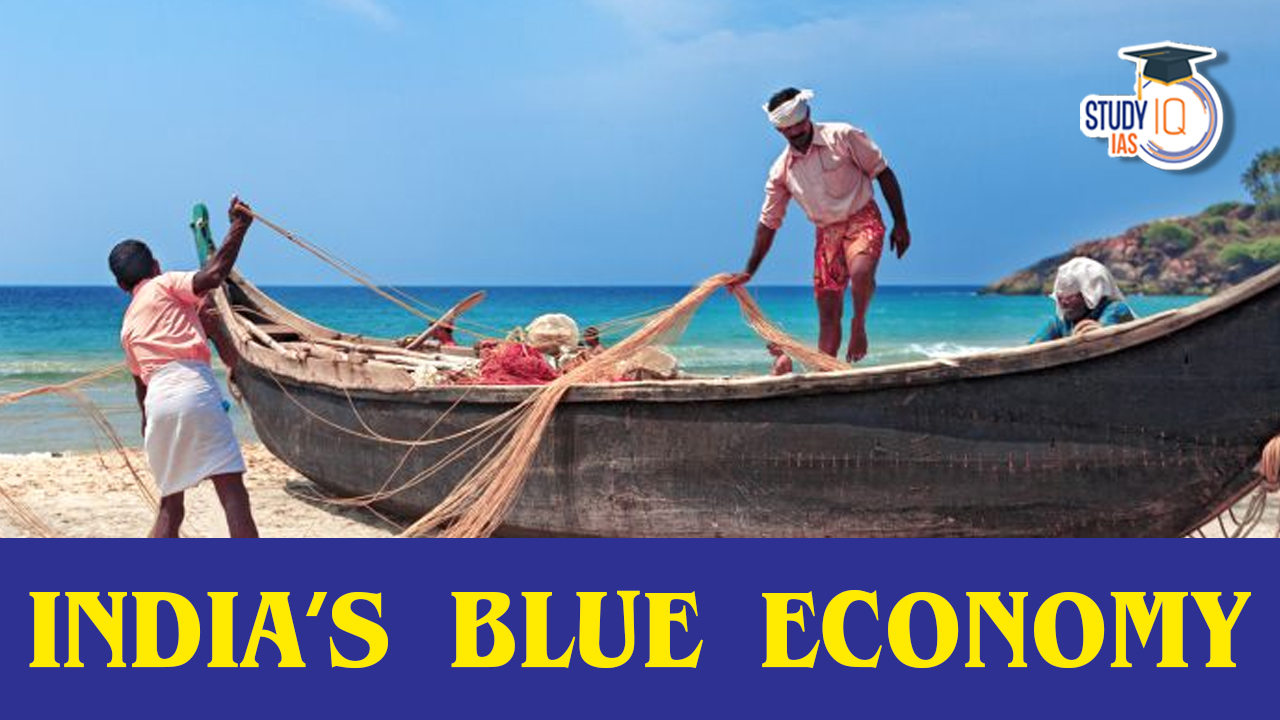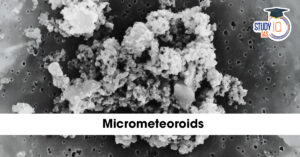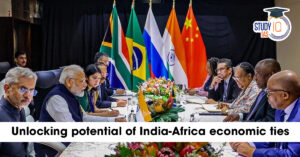Table of Contents
Context: The G20 Environment and Climate Sustainability Working Group (ECSWG) and Environment and Climate ministers meeting that concluded recently adopted a series of “Chennai High-Level Principles” for a sustainable and resilient blue economy.
More on News
- These principles shall serve as a guiding framework globally to drive the transition to a sustainable and resilient blue economy.
- Blue economy refers to advocating sustainable use of ocean resources for economic growth, improved livelihoods, and jobs while preserving the health of ocean ecosystems.
- The Environment ministry said the adoption of these nine principles will not only help conserve ocean biodiversity but also address the consequences of climate change on ocean-based economies in the G20.
9 High Level Principles on Blue Economy:
The 9 key principles that have been adopted on the blue economy are as follows:
- Addressing Coastal and Marine Pollution: The principle aims to tackle pollution in coastal and marine environments caused by various sources, including plastics, air pollutants, and other persistent pollutants, including those derived from the maritime sector.
- Sustainable Exploitation: This principle focuses on promoting sustainable use of ocean resources to ensure economic growth, improved livelihoods, and job opportunities while also preserving the health of ocean ecosystems.
- Illegal Activities: The principle addresses the need to combat illegal activities that negatively impact the marine environment.
- Acknowledging Ocean-Climate Interlinkages: This principle emphasizes the recognition of links between the ocean and climate, encouraging ocean-based economies to understand the opportunities for climate change mitigation and adaptation through sustainable ocean-based actions.
- Protection and Restoration of Coastal and Marine Ecosystems: This principle emphasizes the importance of protecting and restoring coastal and marine ecosystems as part of climate change mitigation and adaptation efforts.
- Harnessing Low and Zero Greenhouse Gas (GHG) Emissions: The principle focuses on utilizing low and zero greenhouse gas emissions sources in ocean-based economic activities.
- Research on Ocean-Based Carbon Dioxide Removal and Sequestration: This principle highlights the importance of research on safe and effective methods of removing and sequestering carbon dioxide from the ocean.
- Promoting Social and Inter-Generational Equity and Gender Equality: The principle advocates for transparent and inclusive approaches that empower women, communities, and Indigenous Peoples to participate in planning, decision-making, and implementation processes related to the sustainable blue/ocean-based economy.
- Support for the Global ’30 by 30′ Goal: The principle reiterates the G20’s commitment to the global ’30 by 30′ goal, which aims to ensure that at least 30 percent of degraded terrestrial, inland water, and marine and coastal ecosystems are under effective restoration, and at least 30 percent of terrestrial and inland water areas, and of marine and coastal areas, are effectively conserved and managed by 2030.
Understanding Blue Economy
- Definition: The World Bank defines “blue economy” as “sustainable use of ocean resources for economic growth, improved livelihoods and jobs, while preserving the health of the ocean ecosystem”.
- Activities: Seafood harvesting (fishing and aquaculture), extraction and use of marine non-living resources (such as minerals and oil and gas), generation of renewable energy (such as offshore wind), and commerce and trade are examples of activities that could count towards a blue economy.
- 14th SDG Goal: Developing a blue economy is also linked to the 14th Sustainable Development Goal.
- It aims to protect “life below water”, which involves the conservation and sustainable use of the oceans, seas and marine resources for development.

- Sustainable Blue Economy Finance Principles: In 2018, the United Nations Environment Programme (UNEP) had laid out the Sustainable Blue Economy Finance Principles.
- It is a framework that investors can use to fund ocean-based industries.
- Financiers can use it as a reference point to see how marine investment can impact livelihood and poverty eradication.
- Global Biodiversity Framework: Targets set out in the Global Biodiversity Framework of COP15 focus on reducing the rate of loss of biodiversity, ensuring the fair and equitable sharing of benefits arising from the use of genetic resources, and restoring degraded ecosystems. It serves as a blueprint for countries to work together and make progress in addressing the global biodiversity crisis.
India and Blue Economy
India envisions a blue economy that will contribute to food security, poverty alleviation, the mitigation of and resilience to the impacts of climate change, enhance trade and investment, enhance maritime connectivity, boost diversification, job creation and socio-economic growth.
- Facilitate Economic Growth: India is the third largest fish producing country, contributing 8% to the global fish production and ranks second in aquaculture production.
- With12 major ports and 187 non-major ports, handling about 1,400 million tonnes of cargo, 95% of India’s trade by volume transits by sea.
- India’s Exclusive Economic Zone is rich in living and non-living resources and holds significant recoverable resources of crude oil and of recoverable natural gas.

- Marine Biotechnology and Food Security: Fish, being an affordable and rich source of animal protein, is one of the healthiest options to mitigate hunger and malnutrition in India.
- Aquaculture & Marine Biotechnology programme was initiated during 1988-89 to support R&D projects towards development of useful products and process from the marine resources.
- Fisheries as a Commercial Enterprise: Having commenced as a purely traditional activity, India’s fisheries are being transformed into a commercial enterprise.
- The sector has shown steady growth and has become a major contributor of foreign exchange. India is among the top 5 fish exporting countries in the world.
- Generation of Jobs: Fisheries provide livelihood to about 15 million fishers and fish-farmers at the primary level in India.
- This sector also generates almost twice the number of jobs, along the value-chain — in transportation, cold-storages, and marketing.
- Marine Tourism: Marine tourism is also a sector that has been one of the fastest growing globally and in India. Particularly in coastal states like Kerala, Karnataka, and Tamil Nadu, coastal tourism has contributed largely to both the state economies and livelihood creation.
Challenges in Building India’s Blue Economy
- Lack of Investment: There is lack of investment in India’s Deepwater fleet. Indian fishing vessels do not venture into rich fishing grounds and most of the fishing is being undertaken in coastal waters.
- Consequently, Indian fishermen have to compete with those of neighbours, Sri Lanka and Pakistan, in restricted fishing grounds.
- Fishing vessels often drift into foreign waters leading to apprehension by navies/coast guards and prolonged imprisonment of the crew.
- Lack of Infrastructure: Since Independence, India’s marine fishery has been dominated by the “artisanal sector” i.e. poor, small-scale fishers who can afford only small sailboats or canoes to fish for subsistence.
- India’s artisanal fishers deliver only 2% of marine fish to the market, while 98% is caught by mechanised and motorised craft.
- The rich resources in India’s Exclusive Economic Zone remain underexploited. Much of the catch from India’s fishing grounds is taken away by the better equipped fishing fleets of other Indo-Pacific countries.
- These countries also indulge in Illegal, Unregulated, and Unreported (IUU) fishing which has serious security and environmental implications.
- Low Level Value Addition: Currently, most of India’s fisheries exports are at a low level of value addition in frozen and chilled form, without going for higher-order “ready-to-eat” or “ready-to-cook” marine products.
- Stress on Coastal Ecosystem: India needs to curb uncontrolled and unplanned tourist activities that cause stress on the carrying capacity of coastal ecosystems, especially those on fragile island territories.
- Environmental Issues: The increase in human activity, trade and commerce and the construction of large-scale infrastructure around these areas, pose a significant threat to the sustainability of these zones.
- Lack of Skilled Human Resource: Shipping and ports require skilled manpower, but to meet the growing and changing demands in this sector India would require re-skilling and upskilling in the future.
India’s Initiatives for Blue Economy
- Pradhan Mantri Matsya Sampada Yojana: Launched in 2020 for sustainable development of India’s fisheries sector with an estimated investment of Rs 20,000 crores over the next five years.
- Draft Blue Economy Policy: It envisages optimal utilisation of all sectors of the maritime domain, from living and non-living resources to tourism and ocean energy for sustainable development of coastal areas. The 7 key areas are shown in the image:
- Sagarmala Initiative: A Union Government’s initiative that aims to promote port-led direct and indirect development and provide infrastructure to transport goods to and from ports quickly, efficiently and cost-effectively.
- Fisheries and Aquaculture Infrastructure Development Fund (FIDF): It was launched by the Union Government in 2018 with a total fund size of Rs 7522.48 crore with the aims to achieve a sustainable growth of 8-9%, in a move to augment the country’s fish production to the level of about 20 million tonnes by 2022-23.

Way Forward
- India needs to evolve a long-term vision for its fishing industry with focus on four areas:
- Mechanisation and modernisation of fishing vessels by providing communication links and electronic fish-detection devices, with artisanal fishers being funded for this.
- Developing deep-water fishing fleets, with bigger, sea-going vessels equipped with refrigeration facilities.
- A DWF fleet will have to be built around the “mother ship” concept, wherein a large vessel would accompany the fleet to provide fuel, medical and on-board preservation/processing facilities.
- Development of modern fishing harbours with adequate berthing and post-harvest facilities, including cold storage, preservation, and packaging of fish.


 Micrometeoroids: Tiny Space Particles, M...
Micrometeoroids: Tiny Space Particles, M...
 India Needs a National Insolvency Tribun...
India Needs a National Insolvency Tribun...
 Unlocking the Potential of India–Afric...
Unlocking the Potential of India–Afric...

























